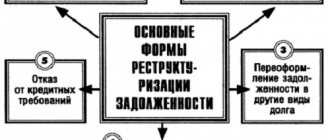According to the legislative acts in force in the Russian Federation, loss of solvency gives the right to both a legal entity and an individual to declare bankruptcy, which leads to the liquidation and write-off of existing debt to creditors. However, you should understand that bankruptcy is a multi-stage procedure, during the implementation of which, first of all, efforts are aimed at restoring financial well-being, as a result of which it will be possible to pay off all debts. If the measures taken do not lead to the desired result, the final stage begins - bankruptcy proceedings . This article will discuss what conditions must exist for the transition to this stage and what actions it involves.
When is the bankruptcy procedure introduced?
The decision to introduce bankruptcy proceedings at a company is made by the arbitration court, which conducts the bankruptcy process of a legal entity. The court makes such a decision based on a petition from the meeting of creditors or the manager. Often, creditors are interested in starting this stage as quickly as possible, since for them this is the only chance to get the debt back in a short time.
Information
Creditors may initially give the debtor a chance to recover through reorganization or the appointment of a professional external manager. But such rehabilitation procedures are not always effective and lead to the restoration of the balance of payments. And in some cases, creditors can foresee in advance the unfavorable outcome of the upcoming rehabilitation. Then they have the right to apply to skip the recovery/external management stages and immediately move to bankruptcy proceedings.
If the parties previously managed to resolve the debt issue in a compromise manner and conclude a settlement agreement, but the debtor-legal entity ultimately did not fulfill its terms and repeatedly failed to meet the payment schedule, then this may serve as a basis for resuming the bankruptcy procedure. Then the court will immediately set the stage of bankruptcy proceedings and will not give the legal entity a “second chance” for recovery.
Thus, the court may introduce bankruptcy proceedings against the debtor in the following cases:
- During the rehabilitation of the enterprise, it was not possible to fully repay the debt to creditors.
- The court considered it inappropriate to introduce stages of rehabilitation for the debtor in case of insolvency.
- The debtor violated the terms of the settlement agreement.
The final stage of bankruptcy of a company is introduced in relation to the debtor if the total value of existing debts to the budget and creditors exceeds the size of its assets.
Important
This arbitration decision must be published in the media. The message must contain information such as details and the date of the decision to declare the legal entity bankrupt, the appointment of a bankruptcy trustee, and the timing of the procedure.
Is there a service for selecting a financial lawyer or determining its rating?
There is no official and centralized one. Whether you trust the many unofficial ones offered by large law firms is up to you. The degree of their reliability is highly questionable, since it is clear that certain companies are interested in promoting “their” candidates. Of course, they will all be certified members of the SRO who have the right to engage in such work. But whether their high assessment is objective is unknown.
So it’s better to use your analytical skills and focus on the official information of the EFRSB. Or consult with lawyers who have had to deal with one or another manager during their work.
Law on bankruptcy proceedings
To date, no separate law has been developed that would regulate the bankruptcy procedure. This stage and the key requirements for it are detailed in the basic legal act dedicated to the bankruptcy procedure: Federal Law No. 127 on insolvency.
For your information
The seventh chapter is devoted to the considered stage of the procedure for recognizing the insolvency of a legal entity. It covers such important aspects of bankruptcy proceedings as the consequences of this procedure, the powers and requirements for the bankruptcy trustee, the assessment of the property of the debtor enterprise, the formation of the bankruptcy estate and the exclusion of property from it, the order of repayment of creditor claims, bank accounts of a legal entity, the sale of property and private aspects of bankruptcy (assignment of claims/replacement of assets of a legal entity, release and removal of the financial manager, etc.).
The essence of the final stage of bankruptcy
The stage of bankruptcy proceedings of a legal entity is aimed at proportionate satisfaction of creditor claims. This is precisely its basic task. Additional ones include the final liquidation of the debtor and the accumulation of his property.
The essence of bankruptcy proceedings can be determined by highlighting its basic distinctive features:
- It is through this stage that most legal entities go bankrupt, since they are characterized by the absolute impossibility of fulfilling their obligations to creditors (the amount of debt exceeds the value of the property they own).
- The interests of creditors in terms of repaying debts to them come to the fore. Settlements with them are carried out according to the principles of fairness and proportionality.
- The tasks of the stage are solved through the accumulation of property into the bankruptcy estate and its further sale.
- The consequence of bankruptcy proceedings is the removal of the debtor from the list of economic entities, because after completion of the procedure, the legal entity is liquidated.
- The management of bankruptcy proceedings is carried out by a specially appointed person, while the top management of the legal entity is removed from business.
- The entire course of the procedure is controlled by arbitration and creditors' meetings to exclude abuses on the part of the manager.
How is the procedure performed?
During the bankruptcy procedure, a legal entity goes through a number of successive stages:
- Holding a creditors' meeting at which the issue of initiating this procedure is put to a vote.
- Making a decision in the arbitration court to start the procedure.
- The appointment of a bankruptcy trustee and the simultaneous removal of former top managers from management and property management of the company.
- Publication of a corresponding message in the media indicating the place of acceptance of creditor claims and the timing of the formation of the register.
- Formation of a register (list) of creditors indicating the debt owed to them. Creditors included in the list receive bankruptcy status. They have priority in the distribution of proceeds over registered creditors.
- Moratorium (suspension) on satisfying creditor claims.
- Formation of a bankruptcy estate from all property owned by the debtor (fixed assets, real estate, accounts receivable, vehicles, etc.). The property that is the subject of the pledge is allocated separately.
- Taking measures to search for property owned by the legal entity and collect existing receivables, analyze the transactions of the legal entity and cancel the managers of questionable and fraudulent transactions in recent years.
- Adjustment of the bankruptcy estate and exclusion from it of property officially withdrawn from circulation, property rights, socially significant objects and other property of clients.
- The bankruptcy estate is being assessed. This can be done by the manager himself or by involving specialized appraisers.
- Organization and conduct of auctions for property included in the bankruptcy estate.
- The satisfaction of creditors is proportionate to the obligations to them and in order of priority from the money supply received at the auction. The law provides for three stages of creditors: the first – claims for writs of execution (liability for causing harm to life/health), the second – debts for wages and severance pay, the third – debts to creditors and budgetary organizations. The latter are to repay obligations to non-competitive creditors (if the proceeds are sufficient for this).
- From the proceeds, procedural costs (for publishing messages, organizing auctions, etc.), legal expenses, current utility bills are paid, remuneration is paid to the manager, salary debts and other expenses of the bankruptcy procedure are paid.
- Reporting of the manager to the creditors' meeting and the court based on the results of the procedure.
- If the judge approves the manager’s reporting, he makes a decision to complete the process of declaring the legal entity insolvency and its liquidation. To do this, you do not need to wait for full repayment of creditor claims. It is usually not possible to satisfy all obligations.
- The manager submits to the Federal Tax Service a court decision declaring the legal entity bankrupt. This serves as the basis for liquidation and exclusion of the company’s entry from the Unified State Register of Legal Entities within 10 days.
- From the moment the mark is made in the Unified State Register of Legal Entities, all powers of the manager are relinquished, bankruptcy proceedings are completed, and the debtor legal entity is no longer a subject of economic activity.
How to file a complaint against a manager's actions
If any of the persons acting in bankruptcy believes that the actions of the bankruptcy commissioner are illegal, violate rights, or the selected manager is completely inactive, then there is an opportunity to appeal his actions. There are several ways to file a complaint:
- Prosecutor's office. A claim of infringement is filed. If the prosecutor's office considers that there are legal grounds and there is enough evidence, the offender will be punished.
- Petition to the arbitration court. There are high chances that the judge will issue a warning to the manager based on your complaint, if, of course, there are legal grounds.
- File a complaint directly with the SRO. This body controls the actions of managers.
- You can file a complaint with the Federal Tax Service of the Russian Federation.
It is worth remembering that the complaint will be satisfied if there are compelling reasons for such an action. It may be helpful to have a lawyer help you draw up such a document. Verbal statements about violation of a person’s rights are not proof. A qualified lawyer will figure out where there was a violation of rights and where there was not.
Insolvency plan
During the bankruptcy procedure, the arbitration manager develops a detailed action plan that he needs to go through to form and fill the bankruptcy estate, as well as repay obligations to creditors. This plan is subject to approval at a creditors' meeting.
The bankruptcy plan specifies the serial number, names of activities and deadlines for their implementation. It is usually developed in tabular form. What activities can be included in the plan for this stage of bankruptcy:
- sending notifications to the company’s management about the dismissal and to the company’s employees about the layoff;
- sending messages to the newspaper Kommersant and the Unified State Register of Legal Entities (about the start of bankruptcy proceedings, the appointment of a manager, tenders, etc.);
- notification of the Federal Tax Service about the most important decisions: the start of bankruptcy proceedings,
- sending various requests to the Federal Tax Service, BTI, traffic police, FSSP, Rosreestr, credit organizations, etc. to clarify the financial situation;
- inventory of fixed assets, intangible assets, cash, expenses, etc.
- holding creditor meetings;
- preparation of reports, etc.
Bidding in bankruptcy proceedings
After inventory and valuation of all property owned by the debtor, the bankruptcy trustee forms the final bankruptcy estate. This is what will be sold at auction. The manager can make an assessment independently based on financial statements or other information. He is not interested in understating the value of the property, as he receives a percentage of sales. But if necessary, participants in the process can appeal the assessment and demand the involvement of external specialists.
Information
Today, all trading is conducted exclusively electronically on specialized platforms. The bankruptcy trustee may choose one of them at his discretion.
The auction is carried out in three stages:
- Raising trades. The starting price is the market price, and the auction step is 5-10% of the original cost. The participant who offers the highest price for the lot wins.
- Bidding with a reduced starting price. Property not sold at the first stage is transferred to the second stage. The initial price is reduced by 20-30% relative to the market price.
- Down trading. Only low-liquid property usually moves to this stage. The one who makes the first offer wins the auction.
To receive funds based on the results of the bankruptcy auction and distribute them among creditors, the arbitration manager opens a special account. All current accounts of the debtor are subject to closure to reduce costs for banking services.
Unsold property, if desired, can be sent to creditors to pay off debts and, if they refuse, transferred to the owners of the business.
What is called bankruptcy estate?
The bankruptcy estate refers to all the property owned by the debtor company that it has at its disposal at the time of the beginning of the final stage of declaring bankruptcy. In this case, the property that was previously left by the bankrupt as collateral is taken into account separately. Very often, in order to most correctly determine whether an enterprise with debt has any property, a person authorized to manage the organization’s assets can involve all the necessary specialists, including auditors and accounting workers.
Bankruptcy trustee in bankruptcy proceedings of a legal entity
The bankruptcy trustee is a key figure in declaring a company insolvent. He is vested with broad powers to ensure the integrity of property and its accumulation, as well as the maximum repayment of a legal entity’s obligations to creditors in the event of bankruptcy. His competence includes the following tasks:
- search for the debtor's assets;
- control of financial flows;
- return of property held by the debtor to third parties to the bankruptcy estate;
- compiling and updating the register of creditors;
- property valuation and organization of auctions;
- settlements with creditors, etc.
Thus, the successful outcome of the process largely depends on the professionalism of the bankruptcy trustee.
Information
The candidacy of the receiver for bankruptcy proceedings is appointed by the court. In this case, the personal interest of the specialist and the presence of connections with the debtor or creditors must be excluded.
An SRO for appointing a manager may be recommended to the court by a creditors' meeting.
If a manager performs his duties in bad faith, ignores the demands of creditors, or is negligent in meeting deadlines, then at the request of the participants in the process he may be removed from work. Moreover, if, through his actions/inaction, the bankruptcy administrator caused damage to creditors or a legal entity, then the penalties may be more severe. Up to the exclusion of him from the SRO, a decision on compensation for losses and the application of the provisions of the criminal code.
A manager performs his functions for a certain remuneration. It includes a fixed amount, as well as a certain bonus percentage depending on work efficiency.
For your information
The fixed remuneration amount is 35,000 rubles. monthly. As for the additional premium part, it depends on the size of the satisfied claims by the creditors. If more than 75% of the obligations have been repaid, the bankruptcy trustee will receive an additional 7% of the amount; more than 50% - 6%; 25% - 4.5%; up to 25% - 3%. The creditors' meeting may establish a different procedure for calculating bonuses.
How to remove or change a manager
Removal or change of manager occurs quite often in practice. Are you not satisfied with the appointed commissioner? Was he expelled from the SRO? Was he unable to cope with his official responsibilities or was he simply inactive? Then you have every right to petition the court with a request to remove and change the manager.
The court must consider the complaint and make its decision. Usually, if there is enough evidence, the court satisfies the complaint. In this case, the SRO submits lists of candidates for consideration by the arbitration court. And a new manager is chosen. The selection involves the judicial authority, the plaintiff and the defendant.
The legislation of the Russian Federation even provides for the liability of the operating company. Responsibilities for this plan:
- Removal from work. The decision is made by the judicial authority upon a petition from creditors.
- Expulsion from SRO members. If the manager's duties are not performed properly, the manager may be deprived of further activities.
- Compensation for losses. In a situation where creditors are able to prove that the manager’s activities led to damage, he will have to cover all material losses at his own expense.
- If the bankruptcy trustee, while holding the position of head of the company, committed offenses, then he may be subject to administrative or even criminal liability.
The outcome of the paperwork depends on the professionalism and qualifications of the bankruptcy manager.
Duration of the procedure
The bankruptcy proceedings cannot last indefinitely. Standard terms are six months. But if necessary, they can be extended by an arbitration court. To extend the deadline, the insolvency practitioner must provide compelling reasons.
Example
A large industrial complex goes bankrupt and additional time is required to inventory and evaluate its property; the manager needs time to find the debtor’s property or collect receivables. The maximum extension period is no more than 6 months. Thus, in total, bankruptcy proceedings cannot legally last more than 1 year.
Where to look for a financial manager?
The easiest way to do this is on the official website of the arbitration court to which the debtor plans to submit an application. Such a site must certainly have a section containing information about SROs of arbitration managers who are ready to provide their services. Then, just in case, you should check the relevance of the information on the EFRSB. You can search for information either by the name of the SRO or by the name of a specific specialist.
Rights and obligations of participants in bankruptcy proceedings
The key parties in the bankruptcy process are creditors, the manager and the debtor.
The bankrupt legal entity itself has the right to file an application for recognition of its own insolvency. He can also defend his interests in court and at meetings. His responsibilities include providing assistance in the work of the bankruptcy manager and not opposing his work.
Creditors in bankruptcy proceedings themselves usually do not have a wide range of powers (unless we are talking about a single creditor). Key functions belong to the creditors' meeting. This is where the most important issues regarding the debtor are resolved. In particular:
- determining the procedure for selling property;
- assignment of claims;
- selection of a bankruptcy trustee;
- petitions for the removal of the manager;
- conclusion of a settlement agreement;
- review and approval of the manager's report;
- appealing decisions and actions of the bankruptcy manager, etc.
The most important functions of managing the company during bankruptcy proceedings are transferred to the arbitration manager. He keeps under control all the property of the bankrupt enterprise entrusted to him and controls creditor meetings.
The list of rights of the bankruptcy trustee in bankruptcy includes the disposal of the property of a legal entity, personnel changes, refusal to execute certain transactions, appealing the actions of a legal entity to alienate property, etc.
External control
External administration is another rehabilitation procedure within a bankruptcy case. The purpose of the procedure is to allow the company to restore its viability and pay off its debts under the guidance of an external manager .
This is the name of the arbitration manager appointed to carry out external management. The period of external management cannot exceed two years (the same as for financial recovery).
The main difference between external management and financial recovery is that the head of the enterprise is removed from his position, and the management of the company is entrusted to an external manager. At the same time, the participants (founders) of the company are very limited in their rights. Their main function is to search for funds to pay off creditors' claims.
External manager in the external management procedure:
- accepts documents and property of the debtor;
- draws up an external management plan, coordinates this plan with the meeting of creditors, and then approves it in court;
- works according to plan in order to improve the health of the enterprise. The meeting of creditors controls this work.
The external management procedure is introduced much more often than financial recovery. Unfortunately, it does not always lead to full repayment of creditors’ claims and restoration of normal operation of the enterprise. Much here depends on the actions of the external manager and the mood of the creditors.
Termination of the procedure
Bankruptcy proceedings are terminated by decision of the arbitration court. Such a decision is made on the basis of reports submitted by the arbitration manager based on the results of the work. The termination of this stage also implies that the process of declaring a legal entity insolvent is considered completed.
Data on the termination of the bankruptcy procedure are transferred to the bankruptcy proceedings manager to the Federal Tax Service and the registration authority issues a ruling on the liquidation of the legal entity. After which all debt obligations from the company are removed, even if the proceeds from the sale of property were not enough to repay them.
How does the EFRSB help in choosing a financial lawyer?
At the moment, this resource offers the most accurate and up-to-date information about all financial managers in Russia. If, for example, the specialist you chose left the SRO, there may not be information about this on the website of the arbitration court. On the EFRSB website there will definitely be a note next to his name - “not a member of the SRO.” There is also a list of disqualified managers on the website. It is important that “your” surname is not in it.
If everything is in order, you will find a professional financial card on the website, which contains his full track record. The services of a manager who has successfully conducted several dozen bankruptcy cases and had no challenges/recusations in their process will be very expensive. So it is recommended to look not for a “star”, but simply for a strong professional who has several successful cases under his belt. Pay special attention to recusals - you don’t need a specialist who will “throw you away” during the process if it seems to him that something did not go as he planned.
Bankruptcy report
To control the activities of the arbitration manager in bankruptcy proceedings, he is required to submit mandatory reporting forms. The manager must report on the results of his work to creditor meetings, as well as to the court.
The creditors' meeting has the right to receive the necessary information about the progress of the bankruptcy process. If a manager does not submit reports on the progress of the bankruptcy procedure of a legal entity within the established time frame, this may serve as a basis for his removal.
Information
According to legal requirements, reporting must be provided at least once a quarter.
The Federal Law on the insolvency of a legal entity contains instructions regarding mandatory sections of reporting. This should contain information about the property owned by the debtor, the amount of creditor claims broken down by priority, information on personnel issues: how many employees were fired, how many of them retained their jobs, etc.
For your information
The manager must also display the results of his work: what claims were managed to be paid as a result of bankruptcy proceedings and in what amount, expenses that had to be incurred, what property was returned to the bankruptcy estate, etc.
At the end of the bankruptcy process, the manager submits final reports to the court (previously, they are sent to all creditors for review). It must be accompanied by a full range of evidence confirming the fact of settlements with creditors, receipt of funds based on the results of competitive bidding, and the creditor register itself. The report is required for the final liquidation of the company.
Financial recovery
Financial recovery is of a rehabilitation nature. The purpose of this procedure is to restore the debtor’s solvency and repay creditors’ claims in accordance with the schedule.
The financial recovery procedure is introduced only when someone provides security for the repayment of creditors' claims. Security is provided in the form of a property pledge, a bank guarantee, a state or municipal guarantee, a surety, etc.
The maximum period for carrying out the financial recovery procedure is two years.
A person who wishes to introduce financial recovery in relation to the debtor sends a financial recovery plan and a debt repayment schedule to the arbitration manager and to the court. The arbitration manager holds a meeting, and if the meeting makes an appropriate decision, the court introduces the procedure. After this, the enterprise continues to work according to plan and schedule, reporting to the arbitration manager. It is important to note that work continues without arrests, blocking, enforcement proceedings, penalties or fines.
The head of the company retains his powers. Restrictions on the activities of the enterprise and its management bodies are insignificant (as well as in the monitoring procedure).
In the financial recovery procedure, the arbitration manager is called an administrative manager . His candidacy is approved by the arbitration court.
As in observation, the role of the arbitration manager in this procedure is rather “contemplative”. He does not take much part in the debtor's work.
The administrative manager reviews reports from management bodies, monitors the implementation of the debt repayment schedule, and provides information to the meeting of creditors. In case of failure to comply with the debt repayment schedule, he requires the persons who provided security to fulfill their obligations.
At first glance, the procedure is interesting, but in practice it is used extremely rarely. In fact, everything comes down to provision. A natural question arises: if someone is ready to vouch for the debtor and is interested in restoring his solvency, why should he post security and enter into bankruptcy proceedings? In this case, it is easier for companies to agree directly with each other and pay off creditors. This will save time and money on the bankruptcy procedure.
To ensure that the financial recovery procedure is used more often, legislators are now working to increase its attractiveness.
Consequences of bankruptcy proceedings in case of bankruptcy of a legal entity
After the institution of bankruptcy proceedings against a legal entity, the accrual of fines and penalties ceases; property alienation transactions are cancelled; information about the financial condition of a potential bankrupt no longer remains a trade secret; senior management is removed from their positions; the seizure of property is cancelled.
The main consequence of bankruptcy proceedings and its logical conclusion is the liquidation of the company and the write-off of all debt obligations from it.








